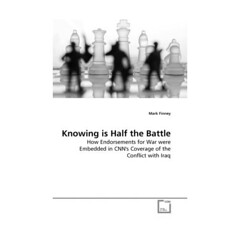
Courtesy Photo: Dr. Mark Finney
Nathan Crites-Herren
The Paw Print
The widely established belief that professional American and international media cong-lomerates are reputable sources of un-biased, fact finding news was poignantly critiqued, during the first of a series of fall Faculty Lectures aimed at raising the consciousness of student, faculty and community members.
Dr. Mark Finney, Assistant Professor of Mass Communication presented “Knowing is Half the Battle: How Endorsements for War were Embedded in CNN’s Coverage of the Conflict with Iraq.”
In his presentation, Finney takes an all-encompassing view of the role that media plays in society, particularly the relatively recent phenomenon of twenty-four hour based television news programs like CNN. Because of CNN’s growing popularity and influence around the world Finney chose to focus his studies on this particular network. Focusing on CNN’s coverage of the war in Iraq, the presentation was framed by looking through the lens of conflict studies, which seeks to find equitable and just solutions for both parties, while favoring a non-violent solution. Using the idea of conflict studies Finney places CNN and the media within the realm of politics, meaning that not only do the media report on conflicts of the day but, by the very manner in which they report, they can dramatically influence the decisions being made about the conflict itself.
Knowing the media’s role in shaping representations of conflicts and their trajectories is essential to clearly understand the landscape of media today, according to Finney. This is particularly true given the fact that since 1970 the number of overall nation and worldwide news outlets, either involved in television broadcast or periodicals, has shrunk from over 240 to only eight. In essence, media is being monopolized in a way that is creating a vacuum of coverage on issues, especially those dealing with conflict. Therefore, this lack of media diversity has limited the public’s information about the world to a narrow and controlled perspective.
News sociology and media studies was also included in the projects research. Questions pertaining to why and how the media represents certain things within their broadcast were explored; giving insight to the fact that media conglomerates are business first, which creates the idea of news as being a sensationalized commodity for sale instead of simply being information used to inform society. “How the journalists conduct themselves, how they are influenced and how their behavior drives their news conduct, demonstrates this type of rating focused reporting,” said Finney.
Using CNN as the object of analysis, Finney focused on CNN’s coverage on the lead up to the war in Iraq and how that coverage informed not only the general public but politicians as well. “It is surprising to know, but in today’s world of twenty-four hour news, politicians rely on media like CNN more now than ever to stay informed,” said Finney.
Not only was the research from the presentation focused on conflict theory and sociology, but scientific methods were also used to strengthen these theories. Research strategies consisted of quantitative and qualitative approaches. The quantitative approach consisted of an evaluation of exactly 400 random CNN news stories about the war in Iraq, in which a rating scale from 1 to 3 was set up to determine the favorability towards war within the reporting. Each time key words like Weapons of Mass Destruction (WMD), evil dictator, non-compliance and Al-Qaeda were used in conjunction with themes heavy in wartime preparation the story was rated a 1 for war favorability. On the other hand, if the story contained content pertaining to conflict resolution, UN talks and the actual legitimacy of the war, the story was given a 3 for not favorable to war.
Qualitatively, Finney’s research demonstrated that stories in which war was favored received more airplay and attention than any other type of story. Over 80 percent of the stories examined used the rhetoric of weapons of mass destruction and non-compliance in their biased support of the war effort. A variety of tonal qualities used for the news reports such as musical themes also presented a sense of tension that made the viewer feel anxiety towards the US Iraqi conflict.

Courtesy Photo: Dr. Mark Finney's book
The research also showed that reporters overwhelmingly favored the opinion of their source that most of the time was a retired military or government official or the White House. “This is a recent phenomenon, before reporters rarely took the word of the White House press releases as a sole source for their story, we are seeing a lack of investigation which makes journalism so vital, a basic undermining of alternative ideas is really what happened within CNN,” said Finney.
According to Finney, “the media doesn’t tell us what to think, but what to think about.” At the conclusion of the presentation that quote could not be truer. Finney drives home the point that the reasons given for the war in Iraq, WMD and the supposed non-compliance of Hussein, were all false pretexts for the war, which were supported by CNN either knowingly or not. This suggests that in terms of conflict resolution, war in Iraq was the goal for not only those reporting at CNN but for the White House as well. Instead of the threat war being a tactic that could be employed to achieve a goal, war in Iraq was the end desired.
When asked about future steps to change the current state of media in our society, Finney stressed the need for more independent news sources that receive their sources from those not affiliated with media conglomerates. Additionally, he stressed the importance of Peace Journalism, which focuses on changing the paradigm from sensational reporting on violence to an approach that focuses on a holistic perspective of conflicts.
What’s Been Said…